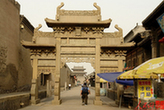How many curios can be contained in a cubed box 30.5 cm long, 30.3 cm wide and 16.5 cm high? One, two, eight, ten? The correct answer is 48! This box, called a square sandalwood curio box with cloud-and-dragon patterns, is one of the dozens of curio boxes kept at the Palace Museum in Taipei.
Curio box with gold engraving and lacquered dragon-and phoenix patternsQianlong era (1736-1795), Qing DynastyH: 25.6 cm, W: 19.5 cm, L: 26.6 cm |
The curio box is a small chest that can collect dozens of curios. The box is often placed in the residence of an emperor with the convenience of taking delight in antiques. It is often nicknamed “emperor’s toy chest”, but the treasured objects kept inside cannot simply be seen as toys. In fact, the cultural connotation of a curio box together with its contents can cover a time span of five thousand years and a geographical sweep of tens of thousand miles.
Every curio box is well designed and full of interest. In the process of opening and closing a curio box, one can enjoy the same feelings as when playing a hide and seek game. One may find a new surprise every time it is played.
Square sandalwood curio box with cloud-and-dragon patterns (containing 47 curios)Qianlong era (1736-1795), Qing DynastyH: 16.5 cm, W: 30.3 cm, L: 30.5 cm |
According to imperial records, curios in imperial court are classified into several ranks and only those ranked at the top can be set into a curio box.
Take the square sandalwood curio box with cloud-and-dragon patterns for example. Among the 47 curios contained, there are jade wares, calligraphy and paintings, cloisonné objects and bronze wares of dynasties, and even exotic items from Japan and western countries.
When the box is opened, the top tray displays several jade wares from the Spring and Autumn Period and Warring States Period to the Ming (1368-1644) and Qing (1644-1911) dynasties. One of the items is a jade tiger from the Warring States Period. It is carved on both sides, shaped like a tiger lapping its front paw. Another is a jade ware with a “chunshui” pattern form the Jin (1115-1234) and Yuan (1271-1368) dynasties. This kind of pattern is closely related with the custom of nomadic Khitans and Jurchen people, where they often hunt wild goose along the river during the spring. Skillful craftsmen make use of this hunting scene on their creation when embroidering clothes and carving jade. This kind of jade ware is called “chunshui” jade.





Why not rent a boyfriend, or girlfriend to please parents during the Spring Festival?